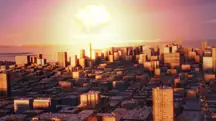With global tensions continuing to rise and nuclear threats creeping back into headlines, fears of a potential World War III have left many wondering: Is there anywhere safe if it all goes wrong?
Surprisingly, the answer might be yes, and the best options aren’t military bunkers or remote doomsday shelters.

According to investigative journalist and author Annie Jacobsen, there are two countries where your chances of survival would be significantly higher in the event of global nuclear war. And they might not be what you'd expect.
In a conversation on The Diary of a CEO podcast with Steven Bartlett, Jacobsen explained that countries in the Southern Hemisphere would be far better equipped to survive the long-term effects of nuclear winter.
Why? Because they’re more likely to sustain agriculture when the rest of the planet can’t.
“Places like Iowa and Ukraine would just be snow for 10 years,” Jacobsen explained. “So agriculture would fail, and when agriculture fails, people just die.”
On top of crop failures, radiation and a destroyed ozone layer would make sunlight deadly in many parts of the world, she warned. That would push survivors underground, leading to brutal fights for food “everywhere except for in New Zealand and Australia.”
Jacobsen cited research from Professor Owen Toon, whose team updated the original nuclear winter theory by focusing on its impact on global food supplies, The Daily Mail reported. The chilling estimate? A full-scale nuclear conflict could kill five billion people, most from starvation rather than the blasts themselves.
So where do the remaining three billion go? “That’s exactly where you’d go,” Jacobsen told Bartlett when he mentioned having just visited New Zealand and Australia. “Those are the only places that could actually sustain agriculture.”
Another key advantage? Their geography. Both countries are far removed from major nuclear powers and likely military targets, putting them at a strategic distance from the initial destruction zones.

Elsewhere, publications like Newsweek and Scientific American have examined how nuclear strikes could unfold in the U.S., and where Americans might be safest.
According to Scientific American, missile silos across Colorado, Wyoming, Nebraska, Montana, and North Dakota would be top targets.
Each strike would require one or two nuclear warheads with the explosive power of 100,000 tons of TNT, creating fireballs that vaporize everything in their path and unleash massive shockwaves.
But Newsweek compiled a list of the U.S. states least likely to be directly impacted.
These include: Maine, New Hampshire, Vermont, Massachusetts, Rhode Island, Connecticut, New York, New Jersey, Pennsylvania, Delaware, Maryland, Washington D.C., Virginia, West Virginia, North Carolina, South Carolina, Georgia, Florida, Alabama, Mississippi, Tennessee, Kentucky, Ohio, Indiana, and Michigan.
These areas are the furthest from known nuclear targets and missile infrastructure, potentially offering some buffer from the initial devastation.
Still, Jacobsen’s message was clear: no one is truly safe in a nuclear war. But if you’re looking for the best possible odds of survival, and the ability to grow food when the rest of the planet freezes, pack your bags for down under.
